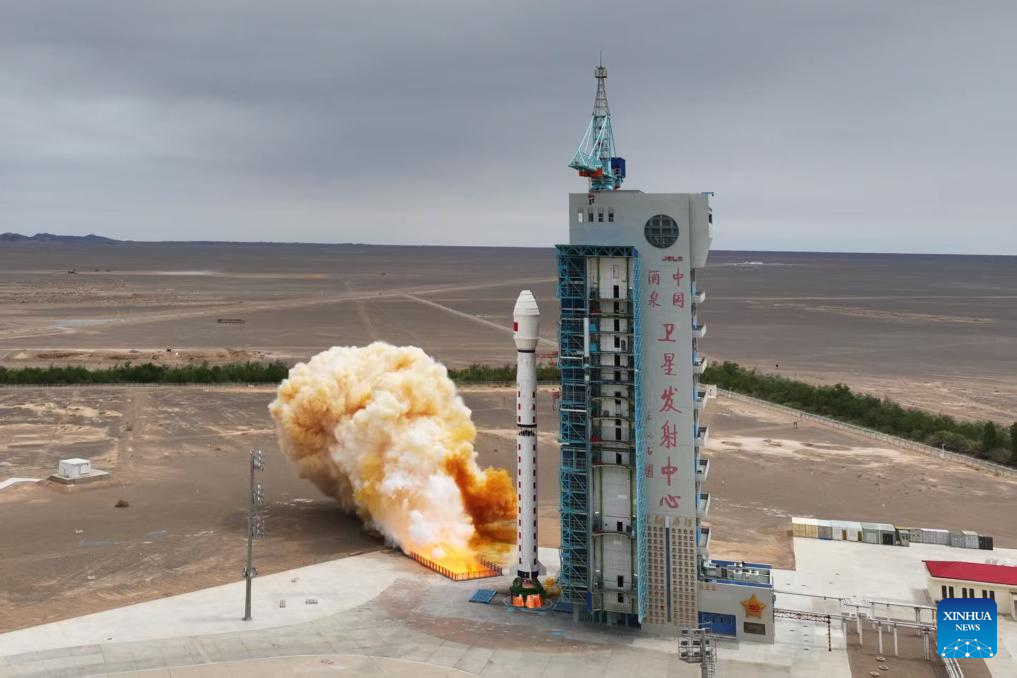21.08.2025
"This is a strategy to keep the US from intervening... that's what their space architecture is designed to do."

US defense officials have long worried that China's Guowang satellite network might give the Chinese military access to the kind of ubiquitous connectivity US forces now enjoy with SpaceX's Starlink network.
It turns out the Guowang constellation could offer a lot more than a homemade Chinese alternative to Starlink's high-speed consumer-grade broadband service. China has disclosed little information about the Guowang network, but there's mounting evidence that the satellites may provide Chinese military forces a tactical edge in any future armed conflict in the Western Pacific.
The megaconstellation is managed by a secretive company called China SatNet, which was established by the Chinese government in 2021. SatNet has released little information since its formation, and the group doesn't have a website. Chinese officials have not detailed any of the satellites' capabilities or signaled any intention to market the services to consumers.
Another Chinese satellite megaconstellation in the works, called Qianfan, appears to be a closer analog to SpaceX's commercial Starlink service. Qianfan satellites are flat in shape, making them easier to pack onto the tops of rockets before launch. This is a design approach pioneered by SpaceX with Starlink. The backers of the Qianfan network began launching the first of up to 1,300 broadband satellites last year.
Unlike Starlink, the Guowang network consists of satellites manufactured by multiple companies, and they launch on several types of rockets. On its face, the architecture taking shape in low-Earth orbit appears to be more akin to SpaceX's military-grade Starshield satellites and the Space Development Agency's future tranches of data relay and missile-tracking satellites.
Guowang, or "national network," may also bear similarities to something the US military calls MILNET. Proposed in the Trump administration's budget request for next year, MILNET will be a partnership between the Space Force and the National Reconnaissance Office (NRO). One of the design alternatives under review at the Pentagon is to use SpaceX's Starshield satellites to create a "hybrid mesh network" that the military can rely on for a wide range of applications.
Picking up the pace
In recent weeks, China's pace of launching Guowang satellites has approached that of Starlink. China has launched five groups of Guowang satellites since July 27, while SpaceX has launched six Starlink missions using its Falcon 9 rockets over the same period.
A single Falcon 9 launch can haul up to 28 Starlink satellites into low-Earth orbit, while China's rockets have launched between five and 10 Guowang satellites per flight to altitudes three to four times higher. China has now placed 72 Guowang satellites into orbit since launches began last December, a small fraction of the 12,992-satellite fleet China has outlined in filings with the International Telecommunication Union.
The constellation described in China's ITU filings will include one group of Guowang satellites between 500 and 600 kilometers (311 and 373 miles), around the same altitude of Starlink. Another shell of Guowang satellites will fly roughly 1,145 kilometers (711 miles) above the Earth. So far, all of the Guowang satellites China has launched since last year appear to be heading for the higher shell.
This higher altitude limits the number of Guowang satellites China's stable of launch vehicles can carry. On the other hand, fewer satellites are required for global coverage from the higher orbit.
SpaceX has already launched nearly 200 of its own Starshield satellites for the NRO to use for intelligence, surveillance, and reconnaissance missions. The next step, whether it's the SDA constellation, MILNET, or something else, will seek to incorporate hundreds or thousands of low-Earth orbit satellites into real-time combat operations—things like tracking moving targets on the ground and in the air, targeting enemy vehicles, and relaying commands between allied forces. The Trump administration's Golden Dome missile defense shield aims to extend real-time targeting to objects in the space domain.
In military jargon, the interconnected links to detect, track, target, and strike a target is called a kill chain or kill web. This is what US Space Force officials are pushing to develop with the Space Development Agency, MILNET, and other future space-based networks.
So, where is the US military in building out this kill chain? The military has long had the ability to detect and track an adversary's activities from space. Spy satellites have orbited the Earth since the dawn of the Space Age.
Much of the rest of the kill chain—like targeting and striking—remains forward work for the Defense Department. Many of the Pentagon's existing capabilities are classified, but simply put, the multibillion-dollar satellite constellations the Space Force is building just for these purposes still haven't made it to the launch pad. In some cases, they haven't made it out of the lab.
Is space really the place?
The Space Development Agency is supposed to begin launching its first generation of more than 150 satellites later this year. These will put the Pentagon in a position to detect smaller, fainter ballistic and hypersonic missiles and provide targeting data for allied interceptors on the ground or at sea.
Space Force officials envision a network of satellites that can essentially control a terrestrial battlefield from orbit. The way future-minded commanders tell it, a fleet of thousands of satellites fitted with exquisite sensors and machine learning will first detect a moving target, whether it's a land vehicle, aircraft, naval ship, or missile. Then, that spacecraft will transmit targeting data via a laser link to another satellite that can relay the information to a shooter on Earth.
US officials believe Guowang is a step toward integrating satellites into China's own kill web. It might be easier for them to dismiss Guowang if it were simply a Chinese version of Starlink, but open source information suggests it's something more. Perhaps Guowang is more akin to megaconstellations being developed and deployed for the US Space Force and the National Reconnaissance Office.
If this is the case, China could have a head start on completing all the links for a celestial kill chain. The NRO's Starshield satellites in space today are presumably focused on collecting intelligence. The Space Force's megaconstellation of missile tracking, data relay, and command and control satellites is not yet in orbit.
Chinese media reports suggest the Guowang satellites could accommodate a range of instrumentation, including broadband communications payloads, laser communications terminals, synthetic aperture radars, and optical remote sensing payloads. This sounds a lot like a mix of SpaceX and the NRO's Starshield fleet, the Space Development Agency's future constellation, and the proposed MILNET program.
In testimony before a Senate committee in June, the top general in the US Space Force said it is "worrisome" that China is moving in this direction. Gen. Chance Saltzman, the Chief of Space Operations, used China's emergence as an argument for developing space weapons, euphemistically called "counter-space capabilities."
"The space-enabled targeting that they've been able to achieve from space has increased the range and accuracy of their weapon systems to the point where getting anywhere close enough [to China] in the Western Pacific to be able to achieve military objectives is in jeopardy if we can’t deny, disrupt, degrade that... capability," Saltzman said. "That’s the most pressing challenge, and that means the Space Force needs the space control counter-space capabilities in order to deny that kill web."
The US military's push to migrate many wartime responsibilities to space is not without controversy. The Trump administration wants to cancel purchases of new E-7 jets designed to serve as nerve centers in the sky, where Air Force operators receive signals about what's happening in the air, on the ground, and in the water for hundreds of miles around. Instead, much of this responsibility would be transferred to satellites.
Some retired military officials, along with some lawmakers, argue against canceling the E-7. They say there's too little confidence in when satellites will be ready to take over. If the Air Force goes ahead with the plan to cancel the E-7, the service intends to bridge the gap by extending the life of a fleet of Cold War-era E-3 Sentry airplanes, commonly known as AWACS (Airborne Warning and Control System).
But the high ground of space offers notable benefits. First, a proliferated network of satellites has global reach, and airplanes don't. Second, satellites could do the job on their own, with some help from artificial intelligence and edge computing. This would remove humans from the line of fire. And finally, using a large number of satellites is inherently beneficial because it means an attack on one or several satellites won't degrade US military capabilities.
In China, it takes a village
Brig. Gen. Anthony Mastalir, commander of US Space Forces in the Indo-Pacific region, told Ars last year that US officials are watching to see how China integrates satellite networks like Guowang into military exercises.
"What I find interesting is China continues to copy the US playbook," Mastalir said. "So as you look at the success that the United States has had with proliferated architectures, immediately now we see China building their own proliferated architecture, not just the transport layer and the comm layer, but the sensor layer as well. You look at their pursuit of reusability in terms of increasing their launch capacity, which is currently probably one of their shortfalls. They have plans for a quicker launch tempo."
China hasn't recovered or reused an orbital-class booster yet, but several Chinese companies are working on it. SpaceX, meanwhile, continues to recycle its fleet of Falcon 9 boosters while simultaneously developing a massive super-heavy-lift rocket and churning out dozens of Starlink and Starshield satellites every week.
China doesn't have its own version of SpaceX. In China, it's taken numerous commercial and government-backed enterprises to reach a launch cadence that, so far this year, is a little less than half that of SpaceX. But the flurry of Guowang launches in the last few weeks shows that China's satellite and rocket factories are picking up the pace.
Mastalir said China's actions in the South China Sea, where it has taken claim of disputed islands near Taiwan and the Philippines, could extend farther from Chinese shores with the help of space-based military capabilities.
"Their specific goals are to be able to track and target US high-value assets at the time and place of their choosing," he said. "That has started with an A2AD, an Anti-Access Area Denial strategy, which is extended to the first island chain and now the second island chain, and eventually all the way to the west coast of California."
"The sensor capabilities that they'll need are multi-orbital and diverse in terms of having sensors at GEO (geosynchronous orbit) and now increasingly massive megaconstellations at LEO (low-Earth orbit)," Mastalir said. "So we're seeing all signs point to being able to target US aircraft carriers... high-value assets in the air like tankers, AWACs. This is a strategy to keep the US from intervening, and that's what their space architecture is designed to do."
Quelle: arsTechnica
